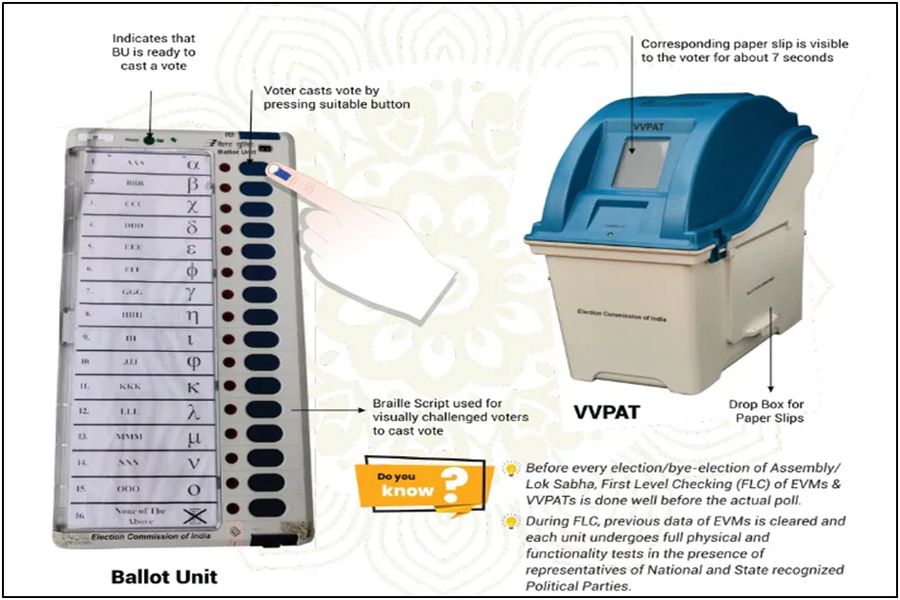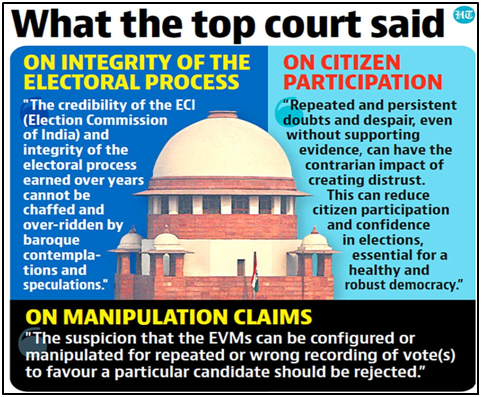Why in News?
- The Supreme Court rejected the demand for 100% verification of Voter Verified Paper Audit Trails (VVPATs) in Indian elections.
- The SC also rejected a return to the earlier ballot paper system for elections - something which opposition parties demanded in recent years.
What’s in Today's Article?
- A Timeline of Introduction of VVPATs in India
- What Have Been the Legal Cases Surrounding the VVPAT?
- What was the Recent VVPAT-EVM Tally Case?
- What has SC Ruled in the VVPAT-EVM Tally Case?
A Timeline of Introduction of VVPATs in India:

- Introduction and field trials
- The idea of the VVPAT machine first emerged in 2010, when the Election Commission of India (ECI), held a meeting with political parties to discuss how to make the EVM-based polling process more transparent.
- After a prototype was prepared, field trials were held in Ladakh, Thiruvananthapuram, Cherrapunjee, East Delhi, and Jaisalmer in 2011.
- Approval of design
- After fine-tuning the design, holding more trials, and taking feedback from political parties, an ECI expert committee approved the design in 2013.
- In 2013, the Conduct of Elections Rules 1961 were amended to allow for a printer with a drop box to be attached to the EVM.
- Introduction of VVPAT
- The VVPAT was used for the first time in all 21 polling stations of the Noksen Assembly constituency of Nagaland in 2013.
- After this, the ECI decided to introduce VVPATs in a phased manner and by (June) 2017, there was 100% adoption of VVPATs.
- Internal audit of VVPAT Slips
- In 2018, the ECI asked the Indian Statistical Institute (ISI) to come up with a mathematically sound and practically cogent sample size for the internal audit of the VVPAT slips with electronic result of EVMs.
- On the basis of which, the ECI mandated the counting of VVPAT slips of one randomly selected polling station per Assembly constituency.
- This was increased to five polling stations per Assembly seat, following a SC judgement in 2019.
- The five polling stations are selected by a draw of lots by the Returning Officer concerned, in the presence of candidates/ their agents.
What Have Been the Legal Cases Surrounding the VVPAT?
- Subramanian Swamy vs ECI (2013): The SC ruled that a paper trail was indispensable for free and fair elections, and ordered the government to provide funding for the roll-out of VVPATs.
- Chandrababu Naidu Case (2019):
- He moved the SC asking for a minimum 50% randomised VVPAT slips to be counted.
- However, the ECI argued that this would delay the election results by five to six days, as it takes about an hour for election officers to match VVPAT slips with the EVM count in one polling station.
- The EC has also highlighted infrastructure challenges, including the availability of manpower, as obstacles to increasing the number of polling booths where VVPAT slips are counted.
- Opposition parties argue that the sanctity of a fair election outweighs the concern of delay in the declaration of results.
- The court ordered the EC to count VVPATS in five polling stations instead.
What was the Recent VVPAT-EVM Tally Case?
- In 2023, the ADR had filed a petition before the apex court saying that to ensure free and fair elections, the tally from Electronic Voting Machines (EVMs)/ data on votes cast, should be cross-verified with the VVPATs.
- The petition (along with other petitions) seeks 100% verification of votes cast on EVMs using the VVPAT.
- To make sure that this process is carried out as fast as possible, ADR suggested the use of barcodes on VVPAT slips.
What has SC Ruled in the VVPAT-EVM Tally Case?

- The SC rejected the demand for 100% verification of VVPATs in Indian elections and also rejected a return to the earlier ballot paper system for elections, thus reposing faith in the electoral process.
- However, the court issued two directions and some suggestions to the ECI in this regard, attempting to ensure that India’s electoral process remains full proof.
- First direction:
- In a first, the court gave directions to the ECI to seal and store the symbol loading units (SLUs) for 45 days after declaration of results.
- SLUs are memory units that are first connected to a computer to load election symbols onto it, and then used to enter symbols of the candidates on the VVPAT machines.
- Second direction:
- The SC has enabled candidates to seek verification of the EVMs - again a first.
- The burnt memory in the EVM microcontroller must be checked by a team of engineers - after results are declared - if candidates (placed 2nd and 3rd in the election) make such a request within 7 days of declaration of results.
- The expenses for this verification will have to be borne by the candidate and which would be refunded in case the EVM is found to be tampered with.
- Suggestion on VVPAT:
- The ECI may examine the suggestion that VVPAT slips can be counted using a counting machine, rather than by humans.
- VVPAT slips could have a barcode printed on them, making it easier for machine counting.









